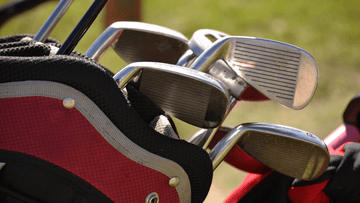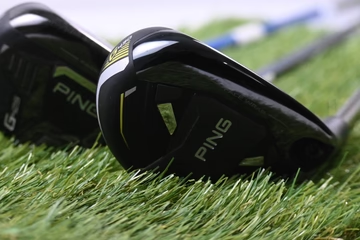In this, our final edition of the popular Ace Series, it’s time to shine our spotlight on the golf putter. The Ace Series covers every type of golf club from drivers through to utilities, fairways and irons, so make sure you check the whole lot out!
Read on to find out all about putters, get some top putting techniques and discover more about the infamous ’yips’. Plus, you’ll find some extra putting resources at the end of this article.


The Ace Series: Your complete, in-depth guide to golf putters


Cleveland Classic Collection #1 Huntington Beach Putter / 34 Inch


Cleveland Huntington Beach #6 Putter / 35 Inch


Cleveland Huntington Beach 1 Putter / 33 Inch


Cleveland Huntington Beach 11 Putter / 35 Inch


Cleveland Huntington Beach 6 Putter / 33 Inch


Cleveland Huntington Beach 6 Putter / 33.5 Inch


Cleveland Huntington Beach 6 Putter / 34 Inch


Cleveland Huntington Beach 6 Putter / 35 Inch
Putters: the absolute basics
The golf putter is the final weapon in your bag of golfing tricks. Once you’ve played your ball down the fairway and arrived on the green, close enough (hopefully!) to the hole, it’s time to get the ball into the hole. And for this, your ‘short game’, you’ll use your putter. Golfers typically only need to carry one putter. There are a few exceptions in extreme circumstances, but generally it’s considered a bit of an extravagance to carry more than one putter within your 14-club limit.
Types of golf putter
The most common categories of golf putter are the blade putter and the mallet head putter. You can also get mid-mallets, toe hang putters and face-balanced putters, and at golfclubs4cash we’ve made sure you can search by all different types of putter so you can arrive quickly at what you’re looking for (we regularly stock over 4000 putters, so you’re bound to find your perfect match!).
To focus on the two main putter types for a moment, while blade putters are a throwback to early putter designs, mallet putters harness modern technology by positioning more mass in the extremities for better MOI (Moment of Inertia). Modern mallet designs are usually square shaped, allowing for increased MOI and giving the appearance of a hammer or mallet shape. ‘Mallet’ is a term that is attributed to any putter that isn’t a blade design (a single, slim flat piece of metal). These days, you tend to see more mallet putters than blades both professionally and recreationally, because of the enhanced performance benefits.


Odyssey Happy Gilmore 2 Putter / 42 Inch


Scotty Cameron Circle T Timeless Tour SSS 350g Putter / 34 Inch / Includes COA


Odyssey Dual Force 330 Putter / 35 Inch


Scotty Cameron Phantom 5.2 2024 Putter / 35 Inch


Scotty Cameron Phantom 2024 5.5 Putter / 34 Inch


Odyssey TEN Triple Track Putter / 34 Inch


Scotty Cameron Studio Style 2025 Squareback 2 Putter / 34 Inch


Scotty Cameron Special Select Newport 2 Putter / 34 Inch

The evolution of the golf putter
Originally, all putters were bladed, typically made from a solid billet of steel that was hammered and pressed into shape, resembling a flat blade of metal in appearance. It was designed to ensure the putter didn’t have too much loft so that the ball could run smoothly over a well-maintained flat surface (the putting green).
Golf putter technique
Your putt is the least athletic and technical shot, and that’s one of the reasons why miniature golf exists – families can all take part as it doesn’t require too much skill and it can be done in a small space. It’s only when golfers become more ambitious that they typically start to scrutinise their putting technique and work on the tiny but important improvements that can give them more confidence in their short game.
Putting is often considered a ‘game within a game’. Golfers typically spend a lot of time and effort working on their golf swing, to gain more distance and accuracy. But if their short game isn’t up to scratch and they take three shots or more to get the ball into the hole, then their scorecard won’t look too impressive.


Combatting the dreaded ‘yips’
It’s not uncommon to hear golfers bemoaning the ‘yips’ on the putting green. This is a mental affliction that can kick in when you’re on the putting green, ready to finish your shot. A breakdown in the nervous system happens and, for whatever reason, you are suddenly seemingly unable to hit the ball straight. Because of the element of precision and fine motor skills involved, you can develop a reflex of apprehension against a missed stroke and this can manifest in a number of ways.
Whereas the ‘shanks’ (shots where the ball hits the hosel of the iron or wedge, for example) can usually be circumvented with some work on your technique, the yips are harder to shake off as they are not a byproduct of poor technique, but rather a ‘mind over matter’ issue. The yips can rear their head in both professional and amateur games, but only ever in putting (with a few exceptions).
When and how to use a ball marker in putting
If your ball is interfering with the intended line of your playing partner, you are required to mark your ball – that is to put something in place of your ball so that you know where to put it back after your partner has taken their shot. As of December 2024, you can mark your ball with anything you like, but it’s courteous to use something small and flat so that it doesn’t obstruct your partner’s ball. Some players use a coin which is flat, round and discreet, while others use a specially designed ball marker which has a combination of lines and shapes to help align your ball to the target, as well as to your putter head.

Choosing a putter as a beginner
Amateur golfers who are new to the game need to select a putter that offers plenty of forgiveness, and obviously cost is usually a consideration too. As a beginner, you would benefit from choosing a mallet putter over a blade putter as it will give you far better forgiveness on mishits.
Shop our full range of forgiving putters here.
Technical considerations of the golf putter
Putter shafts and grips
Putter shafts are almost always made of steel - shop for replacement putter shafts today.
Putter grips are more complex, and are the subject of many golfers’ conversations. A putter grip typically has two different shapes – a pistol and a paddle. The pistol shape is larger and flatter, slightly smaller with more curvature in its circumference, and the paddle is larger and flatter. Historically, grips were made from rubber but these days they’re more likely to be made from foam. SuperStroke is typically considered to lead the putter grip market, and it was this brand that introduced foam to save weight and allow the grip size and shape to be larger. Why larger, you might ask? This goes back to the yips; many golfers believe that the larger the grip, the less active the hands are, so the less inclined they are to develop the yips.

Which are the best putter brands?
Odyssey (now owned by Callaway) professes to lead the market and has a strong heritage in putting, perhaps being most famous for the 2-ball putter which was introduced in around 2000 and is possibly the best-selling putter of all time. This is essentially a mallet design, and if you look down at the putter head from a bird’s eye view, you’ll see two white circles which are the same as the diameter of a golf ball. So, when you position the putter behind your own golf ball, you can determine if your putter head is aligned with your line of stroke – if that’s the case, you’ll get a straight shot.
While Odyssey may have originally led the pack, every single golf brand these days has embraced the benefits of visual alignment technologies. You’ll see anything from a single white dot at the centre of the putter face, right through to a complex combination of lines and/or shapes, all with the intention of helping you align your putter face to the intended line.
When it comes to other leading brands, you’ll see a lot of professional golfers carrying a Scotty Cameron putter and therefore you’ll see plenty of amateur golfers using this brand of putters too.
Which golfers are famous for their choice of putter?
Tiger Woods is a golfer who is famous for not changing his putter, always sticking with Scotty Cameron and it usually looks a bit dishevelled when he pulls it out of his golf bag because of sustained use over a long period of time.
Bryson DeChambeau is known for his harnessing of new-age technology. He uses a SIK putter (SIK Golf was recently acquired by LA Golf). This is a longer putter that he is able to (legally) anchor against his forearm.
And then there’s acclaimed Northern Irish golfer Darren Clarke, who is known for his extensive putter collection because of his penchant for choosing putters by trial and error.
Check out our What’s In The Bag section to see which putters the pros are loving.
You’ll probably notice that quite a few professional golfers use putter prototypes, that is a one-off putter that isn’t available on the general market. This can be because the golf club manufacturer knows that the exposure will build anticipation ahead of a mass production and
launch, leading to a buzz to drive more sales.
But it can also be because elite players have such acute and subjective requirements that an off-the-shelf putter doesn’t quite meet their needs. For these reasons, you are more likely to find one-off putters than any other type of golf club, and that’s why the majority of our limited edition clubs tend to be putters.
Shop all our limited edition, collectible, tour truck and one-off putters
Which putters are bestsellers at golfclubs4cash?
The PING Anser putter is one of, if not the top seller at golfclubs4cash. It’s enduringly popular as it has existed in various guises for over 40 years. (A fact for the pedants among you is that PING Anser is one of the world’s most famous typos. The putter was supposed to be called the ‘Answer’ but they left the ‘W’ out by accident, and the mistake stuck.)
Another eternally popular putter that flies off our shelves is the Odyssey 2-ball as mentioned above, and more recently, the TaylorMade Spyder putter, a putter that has been through hundreds of iterations. And finally, Scotty Cameron is our most sought-after putter brand for aspirational golfers, because it’s widely used by tour pros and has a fairly extensive/popular collectible element to it, too.
More putter resources
- The golfclubs4cash buyers’ guide to putters
- Best putters by brand
- Guide to perfecting your putting technique
- Top ten best-selling putters at golfclubs4cash


Odyssey Happy Gilmore 2 Putter / 42 Inch


Scotty Cameron Circle T Timeless Tour SSS 350g Putter / 34 Inch / Includes COA


Odyssey Dual Force 330 Putter / 35 Inch


Scotty Cameron Phantom 5.2 2024 Putter / 35 Inch


Scotty Cameron Phantom 2024 5.5 Putter / 34 Inch


Odyssey TEN Triple Track Putter / 34 Inch


Scotty Cameron Studio Style 2025 Squareback 2 Putter / 34 Inch











